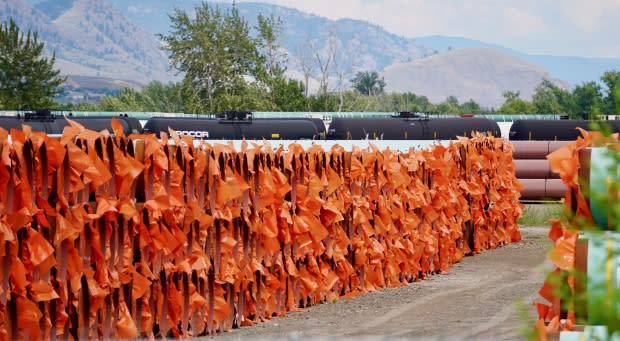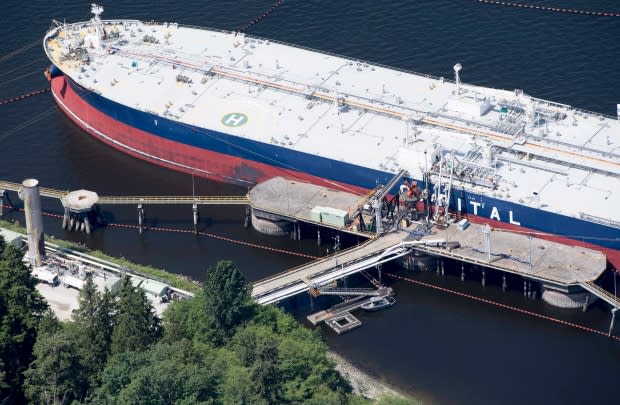What to watch for in today's cabinet decision on the TMX pipeline project
The federal cabinet will decide Tuesday whether to again approve the Trans Mountain pipeline expansion.
An outright rejection of the project is thought to be unlikely, given how much political and financial capital the Trudeau government already has invested in the controversial pipeline — a project that oilpatch boosters have long demanded as a solution to constrained pipeline capacity and perpetually low prices for Canadian oil.
The company building the pipeline — now a Crown-owned entity — already has received about 30 per cent of the pipe needed to build the much-delayed project.
But even if the Trans Mountain expansion gets approval, it may have a long way to go before shovels can hit the ground.
Natural Resources Minister Sohi said Monday that Ottawa is moving forward on Trans Mountain "in the right way" and has "full confidence in our energy sector."
Here are three things to watch for in today's decision.
Pre-construction conditions
In an emailed statement to CBC News, Trans Mountain said it does not have an updated construction timeline but it already has done some of the necessary legwork to start building the line should cabinet give it the green light.
"With a project of this scope and size, there is a long lead time required for the procurement of many of the materials needed for construction. As such, some materials that were ordered and were in transit prior to the court decision are being received at locations in B.C. and Alberta and safely stored and secured for future use," a spokesperson for the company said.

But the regulatory work on the project is far from over. The company will first have to make some required notifications and meet pre-construction conditions, the spokesperson said.
And while it's difficult to pinpoint when it will meet those unspecified conditions, the company likely will have to participate in a series of additional hearings with the National Energy Board (NEB) to secure approvals for the company's preferred route.
The NEB's role in timelines
Cabinet first approved the project in November 2016, when it was still owned by energy giant Kinder Morgan, but the NEB only allowed construction work to begin in August 2018 — and only on the project's first leg, from the Edmonton terminal to its Darfield pump station near Kamloops, B.C. — after months of regulatory meetings.
The NEB typically is tasked with signing off on specific corridors — the TMX project has been divided into four geographically distinct components — after considering the best way to mitigate risks to the environment and the people who live along the route.
By that measure, construction start dates could still be months away.

Coldwater First Nation, a reserve in the B.C. Interior, has long sought a route change for the project to protect against an oil spill in its only aquifer, which supplies 90 per cent of the reserve's water. The First Nation prefers the "west alternative" route that would take the project through another area, farther away from the reserve.
The company has opposed this change, saying the current route is the "best corridor" as it uses the existing right-of-way and would not require any crossings of the Coldwater River.
The NEB is the entity that adjudicates such route disputes. When asked Monday what role the NEB expected to play in the future with respect to pending regulatory approvals, a spokesperson declined to comment.
"The NEB is not able to speculate as to a Governor in Council decision for the Trans Mountain Expansion Project and is therefore unable to speak to what could follow as a result," the spokesperson said.
Improving on 'glorified note-takers'
The company already had started digging along the project's route last August when, only days later, the Federal Court of Appeal quashed cabinet approvals and halted construction amid a legal challenge from some First Nations and environmentalists.
The court said the federal government did not adequately consult with Indigenous groups and failed to adequately consider how the project would affect marine life in the waters off B.C.'s lower mainland.
The decision forced workers to down tools and halt all construction activity underway on the massive $7.4 billion project.
The project's legal woes are tied in part to the government's failure to "meaningfully consult" with Indigenous peoples that would be affected by construction.
The government retained retired Supreme Court justice Frank Iacobucci to reboot the consultation process with Indigenous peoples so the government could meet its constitutional duty to consult with them before making a final cabinet decision.
The court called past Crown consultation teams "glorified note-takers" who documented Indigenous concerns but made few recommendations to cabinet to actually address those concerns.
The previous Crown consultation team believed, erroneously, that it could not add more conditions to the project than those the NEB already imposed as part of its consultation, the court found.
This time, Iacobucci and his team of 60 consultants have been told to turn feedback into action where possible.
If built, the 1,150-kilometre expansion project would nearly triple the existing pipeline's capacity to 890,000 barrels a day. It would allow pipeline shipments from Alberta's oilpatch to coastal B.C., and then to markets in Asia. Tanker traffic from the Westridge Marine Terminal near Burnaby, B.C., would increase from about five vessels a month to one a day.
In issuing its second "reconsideration report," the regulator imposed 156 conditions on the project while also handing Ottawa 16 new non-binding recommendations it said would help address marine safety risks that could result from the addition of more vessels.
The cabinet could make its approval conditional on the implementation of those additional recommendations.



